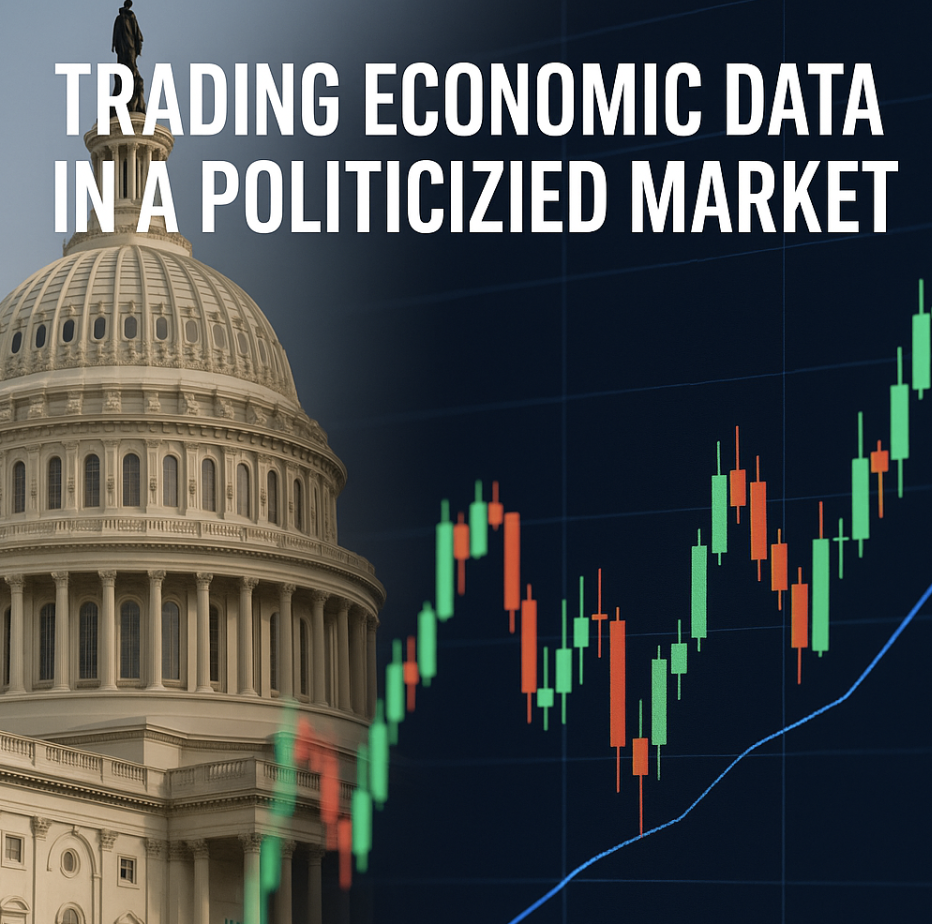Trading Economic Data in an Era of Political Interference: Can We Trust the Numbers Again?
Trading Economic Data in an Era of Political Interference: Can We Trust the Numbers Again?
Traders have always harbored distrust when it comes to information accuracy. Between government politics and wealth inequalities, there are constant revisions to economic data, leaving traders in the dark about the truth behind the numbers. This reality hits hardest every first Friday of the month, when traders around the world hold their breath as the jobs report drops, triggering millions in market movements within seconds—but what happens when the numbers themselves become political weapons? The Trump administration’s recent firing of Bureau of Labor Statistics Commissioner Erika McEntarfer has brought this simmering distrust to a boiling point, forcing traders to confront the fundamental question of whether they can trust the foundation upon which they build their strategies.
Yet paradoxically, this dramatic political intervention—while validating traders’ worst fears about data manipulation—may also represent the first honest acknowledgment of systemic problems that have plagued economic reporting for years. By bringing these concerns into the open and promising methodological reforms, could Trump’s controversial move pave the way toward more transparent and reliable economic data that traders can finally trust?
The Revision Problem: Why Economic Data Changes
Economic data revisions represent an inherent challenge in real-time market analysis, stemming from the technical realities of data collection and processing rather than deliberate manipulation. Preliminary reports are necessarily based on incomplete survey responses that get updated as more comprehensive data becomes available. The scale of these revisions has become increasingly problematic for traders, exemplified by the July 2025 jobs report that revised May and June employment figures downward by a combined 258,000 jobs, completely altering market sentiment and trading strategies built on the original numbers.
While revisions have always been a part of economic reporting, their growing magnitude and frequency highlight the widening gap between the speed at which markets demand information and the time required to produce accurate economic statistics. This creates a complex trading environment where initial market reactions often diverge dramatically from revised reality. This volatility paradox forces risk managers to grapple with position sizing decisions, knowing that the foundational numbers underlying their strategies will inevitably change weeks later.
The Trump Administration’s Statistical Intervention
The breaking point came with the July 2025 jobs report, which showed a dismal 73,000 jobs added alongside massive downward revisions to previous months’ numbers; sending shockwaves through financial markets and political circles alike. Within hours of the release, President Trump fired BLS Commissioner Erika McEntarfer, publicly declaring the data “rigged” and alleging systematic political manipulation during the 2024 election cycle that artificially inflated employment figures to benefit his opponents.
The move shattered decades of precedent that had insulated the Bureau of Labor Statistics from direct political interference since the 1970s, when statistical agencies were deliberately separated from political pressure to ensure data integrity. Former government officials and economists immediately denounced the action as a “dangerous precedent” that fundamentally undermines the credibility of economic statistics. Market participants found themselves grappling with an unprecedented question: if political appointees can be dismissed for producing unfavorable data, how can traders trust any government statistics going forward? The immediate market reaction was swift and severe, with volatility spiking as institutional investors struggled to price assets in an environment where the baseline economic data itself had become politically compromised, setting a troubling precedent.
Trading Strategies for an Uncertain Data Environment
In this era of compromised data integrity, successful traders must embrace contrarian methods, recognizing that economic data releases typically function as volatility suppressors rather than amplifiers. Research shows implied volatility drops following major announcements, creating profitable opportunities for traders willing to sell volatility ahead of releases rather than chase anticipated chaos. However, this strategy demands exceptional discipline as it can fail during genuine surprises or political interference, requiring traders to implement revision-aware position management. Following a disciplined 60-day rule prevents significant allocation changes based on preliminary data, focusing on three-month moving averages rather than volatile monthly prints, and using options strategies to hedge against revision surprises.

Building independence from government statistics becomes crucial through platforms like Trade Ideas, with their AI-driven market scanning based on pure price action. Additionally, private sector indicators like ADP employment reports and purchasing manager surveys offer real-time insights free from political manipulation. Innovative proxies, such as satellite imagery, credit card spending patterns, and job posting trends, provide validation of economic conditions independent of potentially unreliable official reports.
Sector Sensitivities
Understanding sector-specific data sensitivities becomes crucial in this environment. Consumer discretionary stocks face heightened revision risk around employment and retail sales data, as back-to-school and holiday spending patterns can dramatically alter preliminary estimates. Technology companies, while less directly tied to monthly economic releases, become vulnerable when enterprise spending data gets revised, particularly as corporate budgets reset in Q4 planning cycles. Defensive sectors like utilities and REITs may paradoxically benefit from data uncertainty, as investors flee to perceived stability when the reliability of growth metrics comes into question.
Practical Trading Framework and Market Structure Implications
The new reality of potentially compromised economic data demands a comprehensive overhaul of trading approaches and market structure, requiring traders to diversify across data sources beyond government statistics, implement scenario planning for extreme revisions, and position volatility as an asset class. It also requires smaller position sizes and wider stop-loss bands, and establishes clear information hierarchies that prioritize credible agency reports with private sector confirmation and alternative dataset cross-validation. These individual adaptations reflect broader institutional changes as high-frequency algorithms recalibrate for unreliable data inputs. They must now incorporate ‘political risk variables’ into their models, while the Federal Reserve faces monetary policy decisions with compromised statistics, and international investors question U.S. data integrity.
The long-term consequences extend beyond trading profits as the dollar’s reserve currency status depends on statistical credibility, market efficiency deteriorates when pricing data becomes suspect, and pressure for innovation intensifies toward private alternatives. A fundamental shift emerges where political risk becomes permanently embedded in objective economic measurements, forcing every trader to become their own analyst in an environment where data manipulation has moved from conspiracy theory to documented reality.
The Trust Question and the New Trading Reality
The central paradox of Trump’s intervention in economic statistics forces traders to confront whether political oversight can genuinely improve data quality or merely introduces new forms of manipulation. While proponents argue that elected officials should hold bureaucrats accountable, the reality remains that statistics require specialized knowledge rather than political judgment, and most developed economies maintain data integrity precisely by insulating agencies from political interference.
Today’s claimed “improvement” can become tomorrow’s manipulation when political winds shift, yet the practical reality check reveals little has fundamentally changed beyond leadership. For traders navigating this new normal, success demands building anti-fragile systems that diversify across data sources and position volatility as an asset class. Whether Trump’s statistical intervention proves to be genuine reform or accelerated institutional breakdown, traders must be prepared for either outcome while the market determines which reality will ultimately prevail.

